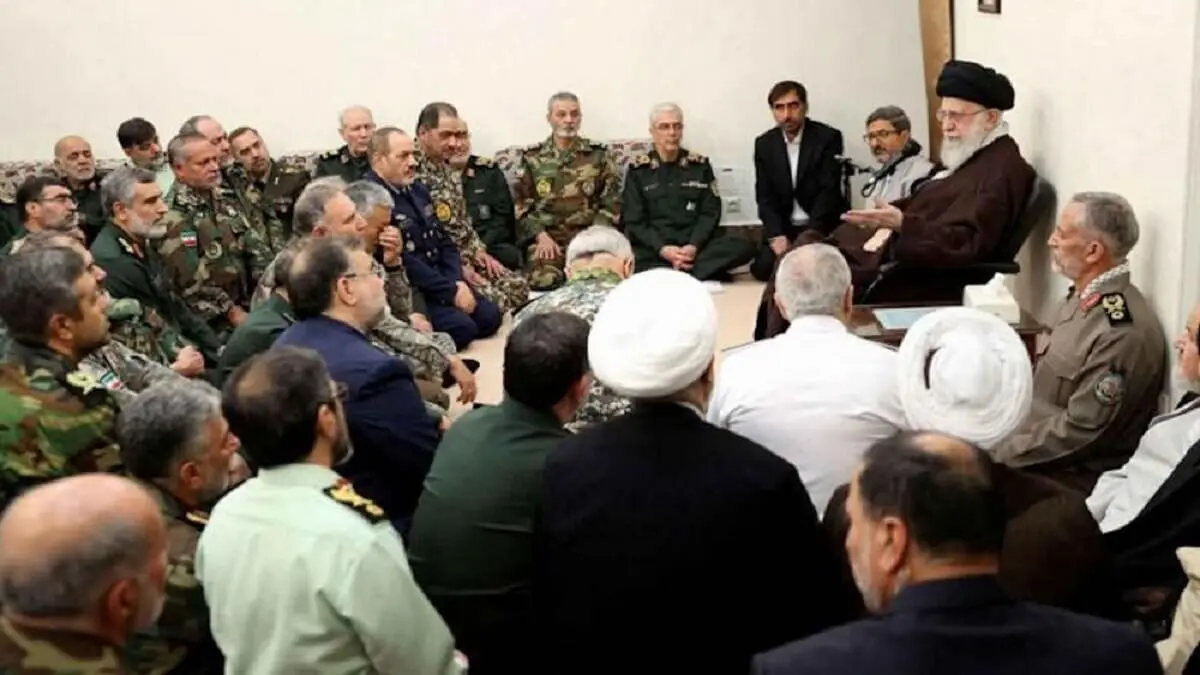Guess who could hatch a coup in Tehran?

Since the end of the Iran-Iraq war, Iran has never felt weaker than it does now. While Tehran was engrossed by its hollow posturing, the Israeli and Western sledge-hammer was demolishing the foundations of Iran’s regional assets. The Israelis realised that Operation “Al Aqsa Flood,” despite the initial shock it caused when it happened, offered them a unique opportunity to strike Iran and destroy the regional alliances it had worked to build, under the contrasting names of the “Shia Crescent” and the “Axis of Resistance.”
Iran had reckoned that the chaos following the panic and feeling of threat which jolted Israel would continue and even evolve into a state of strategic contraction from which Iran could benefit by expanding regionally even further.
Of course, Iran could not imagine that the Israelis and their Western backers would look at events in a wholly different manner, in that they saw that the surprise October 7 Hamas assault could backfire and be exploited to fuel the utmost moral condemnation. The image that stuck with the average Westerner was one of Palestinians attacking Israelis, killing and capturing many of them.
All the existential fears that Israel often voiced suddenly came true with the video footage captured on attacker’s smart-phones and on surveillance cameras. Then, Israel launched its brutal attack on the Gaza Strip in a war of extermination against the Palestinians.
The Iranians only heard what they wanted to hear, while the average Westerner felt no inclination to heed the calls for the criminalisation of the Israeli war tactics. Many of the voices condemning the killing of innocent Palestinian civilians were lost in the mix of theboth genuine and contrived clamour which erupted early on after the Israeli response.
There was enough of time-window for Israelis to change the realities on the ground. And as it came into the picture, Hezbollah’s propaganda complicated the crisis even further. While the Palestinians were attempting to eschew the fallout from their attack, thinking they had already achieved their strategic goals by taking scores of hostages to be later exchanged for thousands of Palestinian detainees, it was too late.
At that point, Israel knew exactly what it wanted to achieve from the war: the complete destruction of Hamas and of the Gaza infrastructure and the launch at the right time of an uncompromising war to end the role of Hezbollah as an abnormal Iranian phenomenon sitting on its northern border under the sole supervision of Tehran.
Israel quickly picked up on Bashar al-Assad’s intent and understood that he was not interested in direct involvement in the conflict, and that the most he could do was to provide a corridor for the channelling of Iranian weapons to Hezbollah in Lebanon. Assad did not want to reward the Muslim Brotherhood/Hamas for causing the Syrian civil war to erupt in the first place. The war would eventually end with the total demise of his regime.
The Iranians failed to decipher the signals of the unfolding developments and understand how far the Israelis were willing to go after having felt that they had paid in advance for the war in terms of the human toll they had already suffered. They were in no way about to retreat. Israel’s two wars, the first in Gaza and then in Lebanon, sapped Hamas’ and Hezbollah pillars of support.
According to testimonies from witnesses close to Hezbollah’s former Secretary-General Hassan Nasrallah, the Lebanese militant party did not realise that the Israelis were prepared this time to go to the furthest possible extent. In fact, Iran itself fed Nasrallah the illusion that a solution would eventually be found, and that Israel would not kill the Hezbollah chief nor decimate the party’s cadres and infrastructure, as it did effectively do later.
The lack of strategic vision may have been passed on by Iran to Nasrallah, leaving him blinded by the sense of impending victory. Hezbollah left events in limbo until Israel began its second military campaign, in which it used elements of cyber power, advanced weapons and intelligence.
Then, Israel began its relentless strikes, and no one found a way to deter it, be it Hezbollah under Nasrallah, Hezbollah under Hashem Safieddine, Nasrallah’s successor, nor Hezbollah on its own. The Israeli strikes ended with Hezbollah agreeing to a ceasefire, albeit reluctantly after losing its elite leadership, cadres, weapons, and, most critically, the trust of its support base.
Regardless of what is said in front of the TV cameras, everyone knows there was a huge sigh of relief the day the war stopped. That feeling was shared by what remained of the party’s leadership, its members, and its grass-root constituencies.
The Turks seized on the moment and acted. Within two weeks, Ankara’s allies from Hayat Tahrir al-Sham entered Damascus to end the rule of the Assad family. With that, the most important link in the chain extending from Tehran to the Mediterranean was broken. This constituted a true fatal blow to Iran.
The Iranians rushed to save what they could, evacuating thousands of their fighters or those affiliated with them, including combatants from Iraq and the region’s various Shia minorities. With the fall of Damascus, the Iranians drank from the poisoned chalice from which they had already drunk when the Iran-Iraq war was stopped. Ironically, the person responsible for the defeat this time was the same person who was responsible for Iran’s failure to win the war in 1988: Ayatollah Ali Khamenei.
When the then-Supreme Leader Ayatollah Ruhollah Khomeini assigned the command of the Iranian armed forces to Hojjat al-Islam Ali Akbar Hashemi Rafsanjani, the then-speaker of parliament, in the last year of the war with Iraq, Khomeini knew that President Ali Khamenei could not win the war. But Rafsanjani eventually came to Khomeini with even worse news: the Iraqis had turned the tide of the war in their favour, and the best the Iranians could then do was to avoid a total defeat at the hands of the Iraqi army.
Rafsanjani persuaded Khomeini to agree to a ceasefire, and less than a year later Khomeini died, leaving the Iranians with the task of finding a replacement for the position of supreme leader, a task with no clearly defined prerogatives.
The Iranians assumed that Khomeini’s spiritual status and authority would automatically pass to his heir. Ali Khamenei was a lucky man: once when he quickly gained all the powers and the status of Khomeini in the wake of the latter’s death shortly after the war, and then a second time when the Iranian regime’s arch-enemy, Iraqi President Saddam Hussein, invaded Kuwait paving the way for the West to destroy Iraq as a major regional power.
The situation was subsequently left to simmer for years during which Iraq’s power eroded through war and siege, and then the curtain fell when the Americans invaded Iraq. Iran thereafter rose as regional power with Ali Khamenei leading the way and performing his role as Supreme Leader as well as was expected of him.
Leading figures from the Revolutionary Guards and the circle surrounding them, such as Iraq’s Popular Mobilisation Forces, Lebanon’s Hezbollah, Yemen’s Houthis, and even the Palestinian Hamas, are the people who turned Khomeini’s dreams into reality and led Ali Khamenei’s wish-list to materialise.
Without dwelling on the names of those involved in the process, one can mention the figures whose posters are plastered all over Tehran’s squares, such as Imad Mughniyeh, Qassem Soleimani, Abu Mahdi al-Muhandis, Hassan Nasrallah or Yahya Sinwar (the killing of Ismail Haniyeh was a demonstration by Israeli intelligence of its prowess but not part of the grand strategic game).
The IRGC commanders dedicated murals to these figures in order to remind Khamenei that the IRGC, with its branches and “sacrifices,” is the one who had made him “emperor” of the “Shia Crescent” empire or the “Axis of Resistance” and the “unifier” of what has become known as the “unity of battle-fields.”
But Ali Khamenei, just as he had failed in the last year of the Iran-Iraq war, failed again in the year of the “Al-Aqsa Flood”. His poor management of the crisis and the conflict led to the loss of irreplaceable figures, especially Qassem Soleimani, Hassan Nasrallah and Yahya Sinwar.
The gloom that shows on the faces of the IRGC commanders when they sit at the feet of the Supreme Leader provides a clear answer to the question of whether Ali Khamenei has gone too far in dilapidating Iranian power, built at an exceptional moment in history and at the expense of every Iranian who every day economically suffers from the consequences of the Western siege and isolation. The only answer is: “Yes, he went too far.”
The Revolutionary Guards are now removing Khamenei’s long-cherished optics. Today we can see the IRGC putting under their control the assets and capabilities of the Iranian state, which is theoretically under the command of the president and the government, who in turn obey the Supreme Leader’s directives.
We are at an historic moment leading to the dismantling of the institution of the Supreme Leader. This outcome will make Ali Khamenei the last leader to rule with absolute powers and let the Revolutionary Guards institution impose its will on the institution of the Supreme Leader, whatever its name.
Whether the IRGC carries out a direct coup and announces the removal of the Supreme Leader, for health reasons or because he had grown old or senile, or wait for him to die of natural causes (the way fate has removed Iran president Ebrahim Raisi, a very likely heir to Khamenei, in a helicopter crash a few months ago), the Revolutionary Guards are rearranging their internal affairs in order to control the government and not leave it in the hands of a half-paralysed aged man.
Khamenei, today, sits and watches the ruins of what remains of his empire, which would look even more desolate if Israel and the West move to complete their strikes on Iraq and Yemen.
A year or more ago, I wrote about potential major changes in Iran, referring to Ali Shamkhani, the Iranian national security advisor who was dismissed by the Supreme Leader in a still- unexplained decision. I hinted at the time at the likelihood that the IRGC would not remain endlessly silent about the atrophy of its influence as a result of decisions by the Supreme Leader who still holds the final word in everything. I hinted then to the possibility that the Guards might want to take action. But the “Al-Aqsa Flood” rushed the process in a different way.
Now the IRGC is laying its hands on the most crucial part of the Iranian economy, which is oil and its revenues. It seems that coups in Iran always begin with oil and control of this vital asset.
Haitham El Zobaidi is the Executive Editor of Al Arab Publishing House.

